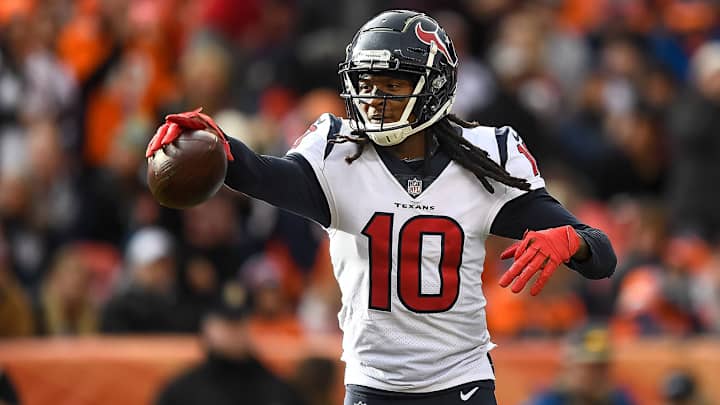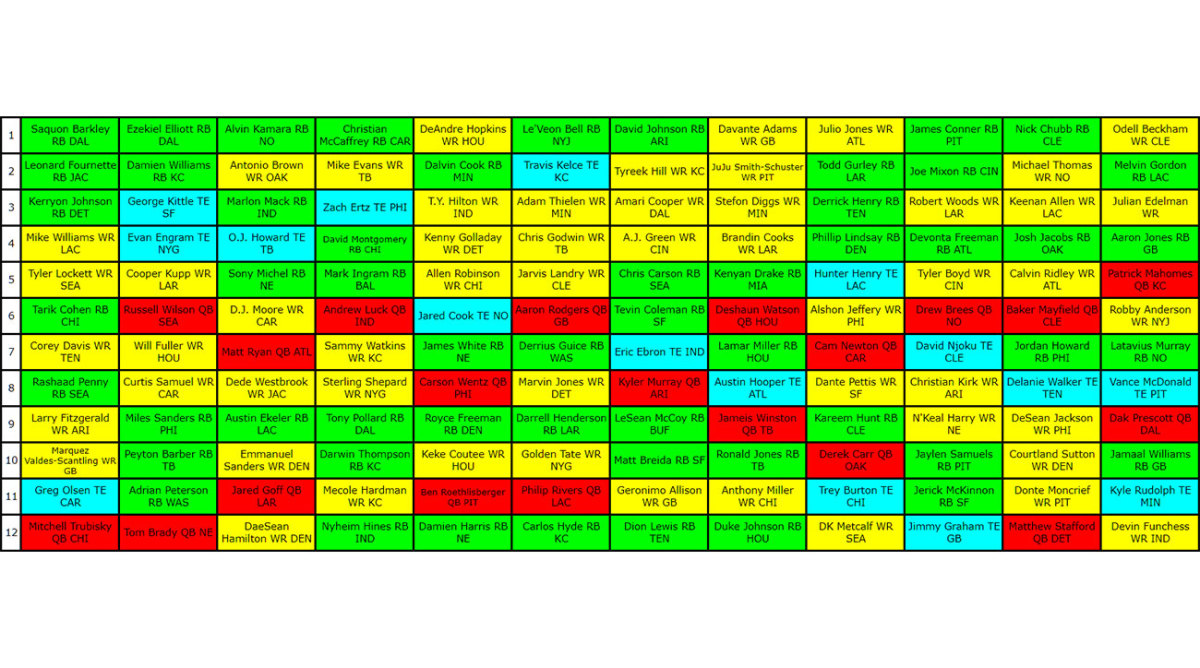Fantasy Football: 12-Team, PPR Mock Draft; Saquon Barkley No. 1, DeAndre Hopkins First Non-RB

Fantasy football has a wide range of games for players with all different levels of experience. For the new player looking to get up to speed on the player pool and draft flow, mock drafts are a great tool especially.
This mock was done with the Sports Illustrated Mock Draft World Championships (MDWC) powered by FullTime Fantasy. You can enter for free, complete a draft in 5 minutes and then watch your team compete all season for a chance to win $2,500.
Each draft can be done quickly, will an option to redo a pick if a fantasy owner wants to rethink his path after making a questionable decision.
Below is a 12-team league with a starting lineup that includes one QB, two RBs, three WRs, two flex (RB, WR, or TE), one kicker, and one defense.
Note: The MDWC is a “best ball format” with six spots on the bench. Each week the computer will automatically set your team's optimal lineup.
To help understand some of the early August draft flow, here’s a look at a recent 12-team mock draft, and then I’ll grade each team’s first 12 picks below.
Check out more information on the rules and a brief interview with the 2018 champion.

Team 1
This team went with an aggressive plan at running back in the first three rounds (Saquon Barkley, Leonard Fournette, and Kerryon Johnson). By being running back strong in this type of contest, the team should fill the first two RB slots in most weeks. The extra options at RB will then flow into the additional flex positions.
Even with a step down in talent at WR, this team has five WRs that look to be top two WR options on their respective team while offering the ability to produce big games. If this draft was weekly league with lineups, the parity at wide receiver could create mistakes in decision making.
This draft was 17 rounds, but I only show the first 12 round as it will be more relevant information for a wide range of leagues.
This roster is well structured with plenty of upside. The most risk comes from Leonard Fournette and Greg Olsen. He cheated both the QB and TE position, which helps build a strong foundation at RB and WR.
Grade: A
Best pick: Rashaad Penny
Team 2
I can’t be a fan of a team that starts with a QB and two TEs over his first six picks in a 12-team format. I understand trying to gain the edge at TE with the idea of the second TE overflowing into one of the flex positions. The problem is magnified on this roster by adding only three WRs after the 12th round. The talent and starting opportunity for WRs drops off severely after Round 12 in most 12-team leagues.
His decision to add two RBs in the 10th (Peyton Barber) and 11th (Adrian Peterson) rounds looks to have more downside than playable value. I would much rather locate pass-catching RBs to help bridge a team from week-to-week at the RB2 and flex positions.
Without seeing his final five draft picks, I have to lower this owner's draft grade.
Grade: C-
Best pick: Curtis Samuel
Team 3
This owner did an excellent job building a DC type roster. He gained an edge at RB1 with Alvin Kamara while catching before the drop-off at WR1 (Antonio Brown). All four of his next selections (Marlon Mack, O.J. Howard, Sony Michel, and D.J. Moore) have upside plus he added two top QBs with big-game ability. Austin Ekeler went much lower than expected. Dede Westbrook brings explosiveness helped by the change in QB in Jacksonville. I view his two receivers on Denver (Emmanuel Sanders and Daesean Hamilton) as really one player in this format.
Grade: B+
Best pick: D.J. Moore (Note: Austin Ekeler could be worth much more if Melvin Gordon doesn’t sign).
Team 4
The draft plan after four rounds (Christian McCaffery, Mike Evans, Zach Ertz, and David Montgomery) owns a consistency factor as well as explosiveness.
Mark Ingram looks overpriced with many fantasy owners failing to understand the drop-ff in value from the high-volume passing game of the Saints to the run-heavy game in Baltimore. Ingram is going to split carries with a second RB along with Lamar Jackson. His pass-catching opportunity is much lower in this offense.
Andrew Luck could be a stud, but he does have risk with his calf-turned-ankle issue. Why pay full price based on his recent news?
His decisions between the 9th and the 11th rounds (Tony Pollard, Darwin Williams, and Mecole Hardman) will leave a massive void in his roster if two of those players don’t earn starting snaps.
I view this owner as inexperienced and lacking a good handle of the value of the 2019 rookie class.
Grade: D+
Best pick: David Montgomery
Team 5
This team structure falls in line with some of the top fantasy owners in the country in the high-stakes market if this league had weekly lineups. In essence, the goal is to have one stud RB with strength at wide receiver. The second RB position tends to be a pass-catcher with the aim of improving that position as the season moves on. His secondary depth at RB (Royce Freeman and Damien Harris) both offer upside along with a chance to start at some point of the season if helped by an injury.
In a DC format, the ability to fill the RB and the second flex position with be the key to success within the league. I don’t know the rest of the roster, which would help raise the overall team value in this format.
Grade: B+ (I would rate higher in a league that set a lineup)
Best pick: Kenny Golladay
Team 6
This owner took a similar path as Team 5 with the start of his team. Each of his first five picks (Le’Veon Bell, Travis Kelce, Adam Thielen, Chris Godwin, and Jarvis Landry) were on point, which should have set up a winning path. Unfortunately, he fell short in his early-season playable options at RB2. I don’t believe Derrius Guice is 100% healthy, which leaves him hoping for Darrell Henderson and Carlos Hyde to fill the second RB slot with no real overflow to the flex position in September. He also took the four-game by picking Golden Tate, which may end up working thanks to his strength at his lead WRs.
Grade: B
Best pick: Chris Godwin
Team 7
Many fantasy owners will take a similar path in their team building through six rounds (three RBs and three WRs). The core of the first half of this team should be competitive as long as A.J. Green doesn’t miss too many games. He did overpay for the injury risk with Green, who should be a sixth-round pick if he misses three games. This owner caught the drop-off at TE (Eric Ebron) while grabbing the upside at QB (Kyler Murray). His decision with his late RBs (LeSean McCoy, Matt Breida, and Dion Lewis) should provide playable stats in many weeks.
Grade: A- (Possible A+ if Green doesn’t miss any games, and this owner hit on the depth at the backend of his roster).
Best pick: Matt Breida
Team 8
Punting the RB position is a tough path in a DC format, but it can have much higher value in leagues with free agency, especially vs. less knowledgeable owners. After starting with four straight WRs (Davante Adams, JuJu Smith-Schuster, Stefon Diggs, and Brandon Cook), this owner tried to gain another edge at QB while looking to roster multiple running that project to be RB2s. His first three WR slots will have a strong score in most weeks along with the QB position. The question then comes down to how much did he give back in his three weaker areas (RB1, RB2, and TE). The Kenyon Drake injury happened after this draft. The handcuff at RB in Houston (Lamar Miller and Duke Johnson) should help in this format.
Grade: B
Best pick: Anthony Miller
Team 9
Even with questions with his team-building, this team has a competitive core in his starting lineup after seven rounds. Each of his starters has a natural drop-down giving him a chance to beat the league average at each position. (This series of articles will help a fantasy owner understand the target goals of each position in their starting lineup in PPR leagues).
He overpaid for Kareem Hunt due to his empty scores for nine weeks, and I would have liked to see a better decision as his backup QB (Derek Carr) and TE (Trey Burton). This success of this roster hinges on Todd Gurley.
Grade: C+
Best pick: Todd Gurley
Team 10
I’m not a fan of the early decision making with this roster. James Conner shouldn’t be drafted in the first round, and Joe Mixon ranks behind some of the RBs that went later in the second round. Robert Woods in front of Keenan Allen is an enormous mistake. Jerick McKinnon in the 11th is going to be wasted pick, and the camp news for K’Neal Harry should have led to him sliding in the draft.
Grade: D
Best pick: Devonta Freeman
Team 11
Nick Chubb was pushed up in this draft, but Michal Thomas slipped. In the end, both players were just drafted in reverse order. More Fantasy owners need to understand the thought process on this turn. I’m sure this owner had Chubb as a target in the draft. He also believes that the next four WRs (Odell Beckham, Michael Thomas, Juju Smith-Schuster, and Tyreek Hill) had similar value. When this happens when a fantasy owner is on the clock, he must choose the position with the most significant drop-off in talent first.
His structure looks excellent after five rounds, but an early QB (Baker Mayfield) almost forced him to chase with his next three selections (Jordan Howard, Delanie Walker, and DeSean Jackson). The backend RB structure is missing, and I’m not a fan of Courtland Sutton (needs another season to develop) or Donte Moncrief.
Grade: C- (First six picks – B+ and last six a D)
Best pick: Keenan Allen
Team 12
I love Odell Beckham this year, and he’s going to be a target at the back-ends of my drafts. I don’t see a reason to invite the risk with Melvin Gordon. I would much instead switch the gamble factor to Todd Gurley or look to see if Gordon would slide to the 3/4 turn.
On the flip side, if Gordon does sign, this team has a competitive structure after seven rounds. I don’t understand why he doubled up a QB inside of round 10 after investing in Patrick Mahomes in the fifth. His TEs (Vance McDonald and Kyle Rudolph) look dull, but they may be serviceable in this format. Jamaal Williams was mispriced by a wide margin.
Grade: C (B if Gordon signs)
Best pick: Patrick Mahomes
